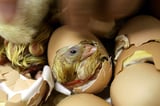Billion-Year-Old Microbe Sheds Light on Evolutionary Origins of Egg Formation
November 18, 2024
In a groundbreaking study published in the journal Nature, scientists from the University of Geneva discovered that the unicellular organism Chromosphaera perkinsii, which dates back over a billion years, produced structures resembling early egg precursors long before the first animals appeared.
This finding highlights the evolutionary link between simple life forms and the emergence of multicellular organisms, as C. perkinsii can form multicellular colonies that resemble early animal embryos.
Remarkably, the organism's cells divide after growth halts, producing an embryo-like structure that can survive for a third of its lifecycle, showcasing unexpected 'egg-like' characteristics.
However, scientists caution that these traits might result from convergent evolution, as this unique developmental process has not been documented in other Ichthyosporeans or closely related organisms.
C. perkinsii, found in shallow seas, predates the first animals, emphasizing the long evolutionary history of egg formation.
Previous studies indicate that hard-shelled eggs similar to chicken eggs emerged around 300 million years ago, while the first eggs were formed over a billion years ago.
This research adds to the ongoing exploration of the chicken-or-egg dilemma, following a 2018 study by Australian physicists that suggested both could emerge first through a quantum mechanics perspective.
The study underscores the importance of understanding microbial diversity to answer questions about animal development and evolution.
Marine Olivetta, a co-author of the study, emphasized the significance of linking C. perkinsii to the evolutionary history of egg formation, allowing researchers to trace biological developments back over a billion years.
The findings metaphorically illustrate a 'primordial egg drop soup', shedding light on how simple cells evolved into complex structures leading to multicellular organisms.
Overall, this research highlights the complexity and versatility of even the simplest life forms, opening new avenues for understanding the evolutionary mechanisms that led to the emergence of multicellular animals.
The publication prioritizes accessibility, ensuring quality journalism is available to all, which is crucial for disseminating important scientific discoveries.
Summary based on 8 sources
Get a daily email with more Science stories
Sources

New York Post • Nov 18, 2024
Which came first: the chicken or the egg? Scientists claim to answer age-old question
The Independent • Nov 18, 2024
Scientists may have finally cracked mystery of what came first: chicken or egg
The Mirror • Nov 18, 2024
Scientists finally figure out whether the chicken or the egg came first
ScienceAlert • Nov 18, 2024
Scientists Reveal a Shocking Solution to The Chicken or Egg Paradox